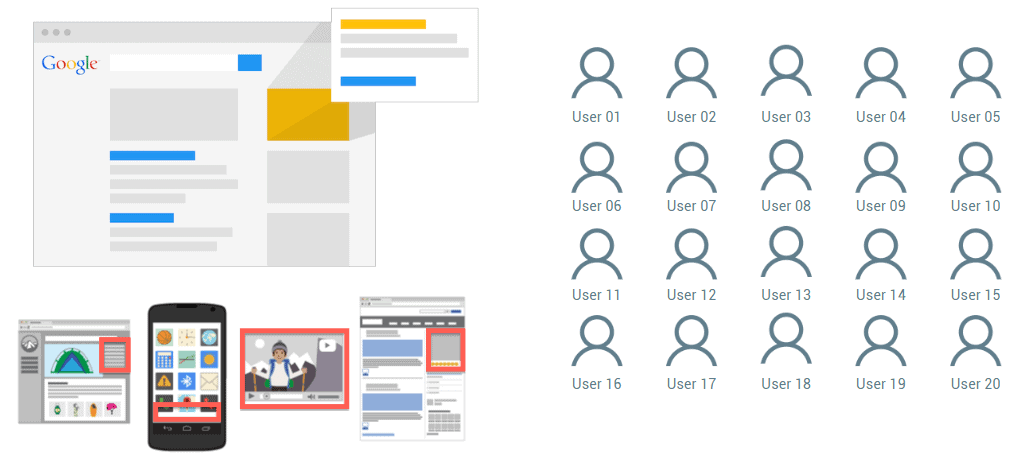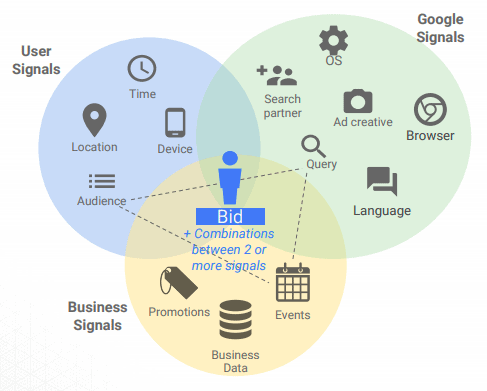

Initially absent from Google Ads (formerly Adwords), the concept of target audience reaches the advertising network in 2010. The arrival of Facebook in the advertising market in 2007 with the promise of being able to target individuals via their profiles pushed Google to follow suit. So far, Adwords has been offering its advertisers to target search terms on their engine or affinity placements on their AdSense inventory and Display network. In 2010, the first audience on Adwords was the advertiser site itself, which allows the advertiser to remarket with Google.
Almost ten years later, Google Ads has developed new possibilities. How to exploit these audiences? How to analyze its performance of campaigns with the notion of the audience? Which strategy to adopt?
Let’s discover the stakes of search engine marketing (SEM) as part of a Google Ads audience strategy.
- What is the audience?
- Group your audiences
- Different types of audience
- Audiences from Google data
- Audiences from Advertiser Data
- How to exploit audiences?
- The types of audience available by type of campaign
- Custom audiences: your audience, created by your care
- Maximize the transformation of your traffic
- Harness your CRM data
- Audience Optimization Strategy
- Prerequisites and best practices before optimizing
- Optimization method
- New upcoming hearings
What is the audience?
An audience is a user profile based on one or more criteria.
Every second, many users search the Internet or browse sites/applications. The constitution of a hearing amounts to proposing an answer to the question: “ Who are they? ”.
Google uses multiple sources of data to qualify the profile of its users, the main ones being:
- The search history,
- Gmail Messaging,
- Browsing history (via Chrome or the Google Display Network),
- YouTube history,
- Google account activity.

Using audiences in the Google Ads control room qualifies profiles of users who may be exposed to your ads.
Group your audiences

- Good practice is to already classify users into 3 large clusters:
- Customers : Already users of your services, they present a challenge of potentiation and retention.
- “Hot” leads : This is your “incubator” where we classify the users who have interacted with your services, but who are not yet customers. We can also talk about Lead Nurturing’s strategy.
- Prospects : Users who are a target for your services and have never interacted with your brand.
Today, at JVWEB, an e-marketing agency specialized in SEO, we estimate that an advertiser misses 20 to 30% of its conversions if it does not use an audience strategy.
If we take the subject from another axis, the AdWords account performance analysis tool, Seiso, shows that an advertiser can waste up to 45% of its budget on irrelevant audiences ( to exclude therefore from his campaigns).
Different types of audience
Audiences are determined from different data: data from Google or data from the advertiser.
Audiences from Google data
- Demographic /Geographical: Allows you to reach or exclude people who are most likely in the same age, gender, parental status, or income group.

- Affinity: Enables you to reach or exclude people who are actively looking for products and services like yours.
- In-Market: Allows you to reach or exclude people interested in products or services like yours.
- Similar: Find new users that are the same as those in your remarketing lists ( -29 % average cost per acquisition observed – source: JVWEB ) or similar to interests, or (and then it becomes mighty) a list of Customer Match.
Audiences from Advertiser Data
- Visitors: Allows you to reach people who have already visited your website. This is called remarketing or retargeting. Decrease of the average acquisition cost observed for this hearing in Remarketing List For Search Ads (RLSA): – 44% (source: JVWEB).
- CRM: Reach people who are from your CRM database from the qualifying elements that it can provide. This is called Customer Match.
- ???? NB: it is more than strongly advised to provide to Google Ads an encrypted data file, especially if you go through a tier (consultant, agency …) to manage your campaigns.Decrease of the average acquisition cost recorded for this Customer Match hearing: – 57% (source: JVWEB).
How to exploit audiences?
The types of audience available by type of campaign
Type of campaign Type of audience
Search & Shopping Audience on the market, remarketing, Targeting by customer list, Similar hearings.
Display Custom affinity / affinity audience,Personalized intention, market audience,remarketing,Similar hearings.
Video Custom affinity / affinity audience, Personalized intention, life events, market audiences,remarketing,Targeting by customer list,Similar hearings.
Custom audiences: your audience, created by your own care
You know better than anyone what users are likely to be inspired by your brand. This is where your business expertise should allow you to control the automation of the tool.
The method :
- Identify your target heart,
- Touch them with a minimum of waste,
- Measure your performance with these audiences.
It is necessary to think of its approach by audience according to the level of engagement of your prospects.
Maximize the transformation of your traffic
Use retargeting in Search and Shopping
To this must be added the behavioral dimension: we must take into account the level of depth of the conversion tunnel and the level of commitment of the user that you will target.
???? NB: The conversion rate in retargeting via the Shopping + Search network is 20% higher than in the standard survey (source: JVWEB) .
So you can create three different lists with separate bid strategies to target users based on their level of engagement in the conversion path.
We recommend that you start your campaigns by setting high enough bids to improve your learning curve and reduce the time you spend in the optimization phase.
Use similar audiences
Google Ads automatically adds similar audiences based on your own viewers.
Harness your CRM data
Segment your database to export as many contact lists.
Then integrate them as Customer Match audience lists in the Google Ads interface
Audience Optimization Strategy
Prerequisites and best practices before optimizing
Before you start, make sure everything you need is in place:
- A Google Ads remarketing tag is present on all pages of your site.
- You have allowed Data collection for remarketing in Google Analytics, and your Google Analytics account is linked to your Google Ads account.
- Your audience lists are well created with a satisfactory level of granularity while keeping for each a floor size ( 100 contacts per list minimum ).
- All your audiences are added to your campaigns in ” Observation ” mode.
We also advise you to:
1. Use Audience Insights to identify the types of profiles your audience has.
Use the audience statistics tool accessible in the Google Ads account

2. Create duplicate audiences with Google Ads and Google Analytics to maximize the size of your lists.
3. Allow time and observe performance when volumes are significant before making decisions (2 weeks to 3 months, depending on the activity level of the account).
Optimization method
A Google Ads Seiso report can immediately identify the best and most problematic demographic audiences, at the overall account level, but also for the most important campaigns.
On this basis, the optimizations to envisage:
- Adjust your auctions up or down depending on the performance of your audience (based on the ROI or the cost per acquisition).
- Exclude audiences that are not performing well.
- Offer personalized messages.
- Use Smart Bidding and feed the Google algorithm with your data
Finally, consider customizing your messages within the same ad with the “if” function. So you can fine-tune the communication or push relevant offers (for example coupon first purchase for prospects, free delivery for customers …).
From a business point of view, it can be essential to integrate the notion of lifetime value into your audience strategy.
Indeed, depending on your business model, it may be that a customer’s profitability is achieved after several conversions.
In Google Analytics, you will find a report on the value of the customer. Customer value data is available in all Analytics accounts. No modification of the tracking code is necessary.
- Sign in to Google Analytics,
- Access your view,
- Open the Reports section,
- Select Audience and then Customer Value.
Google is based on a traditional RFM (Frequency Amount Frequency) to calculate a relative value of the client on 90 days maximum (for now).

With this crossover data, Google will generate different audiences that will be imported into your Google Ads account and that you will be able to notice with different bid strategies (we usually recommend a Target CPA or Target ROAS strategy).
It seems that this report is useful from 1000 conversions/week.
New upcoming hearings
Some accounts can find audiences with little or no data.
For example, Google Ads hearing about household income.
Google ad teams have announced that significant progress will be made on these reports to provide advertisers with maximum data for their optimizations.
The new audiences:
- Parental status: today limited to a simple yes/no, the familial status of the user will be enriched with data about children: number, age and grade level.
- Marital status: this new hearing will help to know if the user is single, married, or in a couple (out of wedlock).
- Level of education : User’s level of education – Bac and Master.
- Housing : Does the user own or rent their home?
The importance of audience strategies in an automation context
Google Ads is in the direction of growing automation of campaign management (Smart Bidding, Smart Shopping …). To stay in control of his actions and machine, the advertiser will have less need to be a technician but will have to strengthen the finesse of its strategic approach.
Audience strategies are therefore essential to master in this context: they will optimize costs by excluding unprofitable segments and maximize volumes on high value-added audiences.
